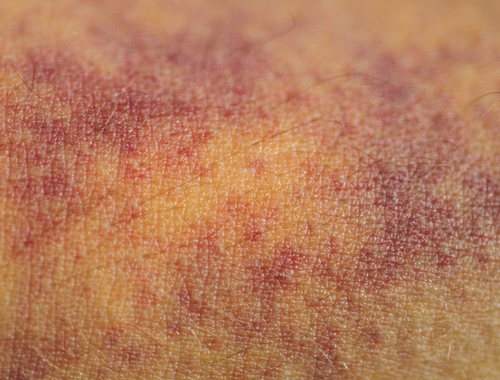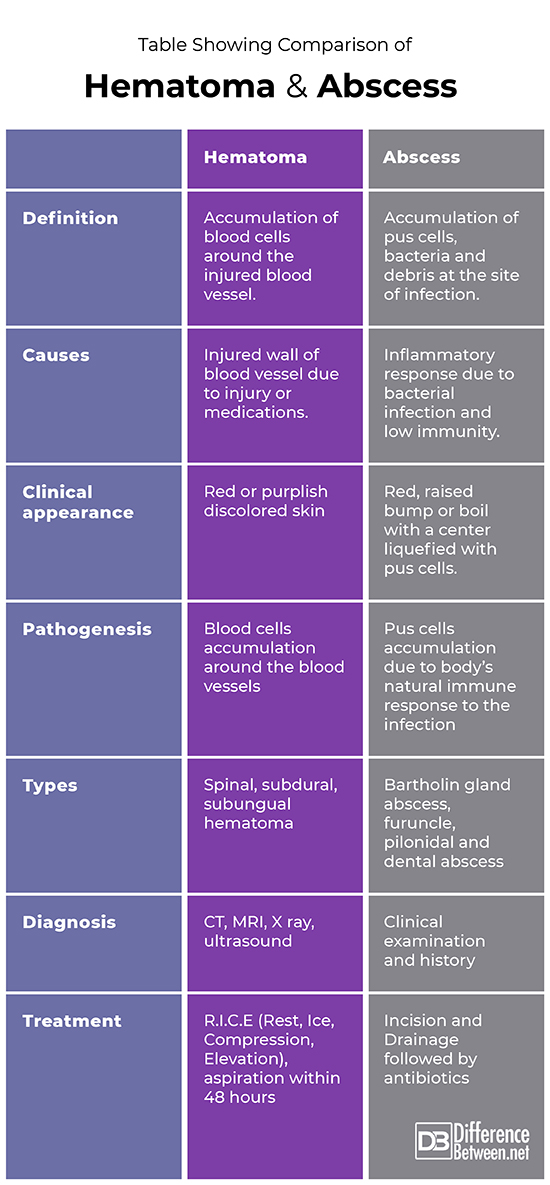Difference Between Hematoma and Abscess
A Hematoma is a collection of blood outside and around the blood vessels as a result of rupture of the wall of the blood vessel. An abscess is a collection of pus a result of chronic inflammation or infection.

What is a Hematoma?
Definition
A Hematoma is a collection or pooling of blood around blood vessels as a result of trauma or injury to the wall of blood vessel.
Pathogenesis
An injury to the blood vessels causes pooling of blood cells in the surrounding area.
The surrounding areas are irritated by the blood cells and result in inflammation.
Inflammation causes redness or even swelling, which results in purple or red discoloration.
Types
There are different types of hematoma depending on the location of injury.
Examples are:
- Spinal hematoma
- Subdural hematoma
- Subungual hematoma (under the toenail bed or finger)
- Hepatic hematoma (in the liver)
- Ear hematoma
Clinical Presentation
Usually minor and superficial hematomas are presented without any systemic symptoms. They appear as red or purplish discoloration of skin or mild edema.
However, hematomas with ruptured arteries can present symptoms like:
- Headache
- Dizziness
- Back pain
- Loss of bladder and bowel movements control
- Nausea and vomiting
- Abdominal pain
- Pain in finger or loss of whole nail
Causes
Some of the main causes are:
- Fracture of pelvic bone
- Injury in the nail bed
- Deep venous thrombosis (DVT)
- Blood clots that mobilize
- Leukemia
- Alcohol abuse
- Medications like blood thinners
- Different aneurysms
- Diseases like viral infections that cause thrombocytopenia
Diagnosis
- Clinical examination and history
- X-rays if associated with bone fracture
- CT scan and MRI if internal bleeding is suspected
- Ultrasound if pregnancy
Treatment
Treatment depends upon the type and location of hematoma.
A superficial hematoma without internal bleeding can go away on its own and doesn’t require any vigorous treatment except
- OTC anti inflammatory
- Aspiration if presented within 48 hours of injury
- R.I.C.E (rest, ice, compression, elevation)
More serious cases of internal bleeding may require surgeries to anastomose the blood vessels and stop the bleeding.

What is an Abscess?
Definition
A soft mass of pus, bacteria and debris that can be felt as a raised bump on the surface of skin and caused due to infection.
Pathogenesis
Bacteria enter the skin as a result of minor trauma which causes the skin barrier to break. Bacteria triggers immune response, which accumulates the white blood cells in the form of pus at the location of infection.
The center of the abscess contains liquefied mass of pus and bacterial debris, with tension in surrounding tissues due to inflammatory response. This results in raised, warm and tender mass known as abscess.
Types
Types of abscess depend upon the location and organs involved, for example:
- Bartholin gland abscess (under armpit, around anal or vaginal hair follicle glands)
- Pilonidal abscess (at the base of spine)
- Dental abscess (due to infection in a tooth or periodontal tissues)
- Furuncle (a boil on the groin region)
Clinical presentation
- Painful, compressible mass
- red or bright pink color
- Warm to touch
- Tender to touch
- With progression of infection, a head is formed on the center which can be ruptured to drain the debris inside
- Once infection spreads to the underneath tissues, fever and symptoms of infection arise.
Causes
People with low immunity are at higher risk of developing an abscess. For example:
- On steroid therapy
- Undergoing chemotherapy
- Having ulcerative colitis
- Diabetic
- Sickle cell Anemia
- Peripheral vascular diseases
- Alcoholic or drug addicts
- Obese people
Diagnosis
Clinical examination.
Detailed medical history to rule out the cause of abscess.
Treatment
- Your doctor will drain the abscess by applying local anesthetic and giving a small incision.
- After drainage, oral antibiotics are prescribed to cure the infection completely.
- Do not attempt to poke or open the abscess by yourself.
- Always seek medical help immediately if abscess is accompanied by fever.
Difference between a Hematoma and Abscess
Definition
Hematoma is accumulation of blood around the injured blood vessels while an abscess is accumulation of pus and bacteria at the site of infection.
Pathogenesis
Hematoma is the result of blood cells that pool around the injured blood vessels as a result of trauma while abscess is a result of body’s immune response that leads to accumulation of pus, bacteria and debris.
Symptoms
Hematoma presents as discolored, tender bruise on the surface of skin with no fever and rarely swelling while abscess is a raised, soft mass with center of liquefied pus, debris and bacteria which can be accompanied by fever.
Causes
Hematoma is caused due to trauma or injury, use of medicines like blood thinners, and reduced platelets count while abscess is caused due to compromised immune system due to diabetes, steroid therapy, cancer treatment, and other autoimmune diseases.
Diagnosis
Hematoma if associated with symptoms of internal bleeding is diagnosed by X-ray, CT scan, MRI scan or ultrasonography. Abscess is diagnosed by the clinical examination, and history, presented by the patient.
Table showing Comparison of hematoma and abscess

Summary of Difference between Hematoma and abscess
- Hematoma is pooling of blood around the injured blood vessels while abscess is accumulation of pus cells, bacteria and debris at the site of infection.
- Hematoma presents as red or purple discoloration of skin without fever or other symptoms when mild while abscess is accompanied by fever and presents as a small, raised bump which is tender to touch.
- Hematoma can be a result of blood thinning drugs or trauma to the blood vessels while abscess is a result of bacterial invasion which triggers immune response and accumulation of pus cells due to low immunity.
- No antibiotics are required for the treatment of hematoma while abscess requires antibiotics administration.
- Hematoma is treated without surgery when mild while abscess requires incision and drainage.
FAQs
Is a hematoma an abscess?
A hematoma is not an abscess as long as it is not infected.
What are the two types of hematomas?
Two main types of hematoma are spinal and subdural hematoma.
Can a hematoma turn into an infection?
A hematoma can turn into an infection when left untreated for long but its rare.
Does a hematoma need to be drained?
An auricular (ear) hematoma needs to be drained to prevent the disruption of blood supply in the ear.
Is draining a hematoma painful?
Drainage of subungual hematoma can be very painful and requires 18 gauge needle, and local anesthesia.
What can be mistaken for a hematoma?
Various soft tissue tumors can be misdiagnosed for hematoma due to similar clinical features and presentation.
When is it too late to drain a hematoma?
A hematoma presented within 48 hours can be drained by 18 gauge needle. After 48 hours it’s too late to aspirate.
What happens if the hematoma is not drained?
If a hematoma is not drained, it can damage the surrounding tissues and might turn into an infection.
How do you know if a hematoma is serious?
A hematoma is serious if it keeps on increasing in size instead of resolving. Immediate medical help should be called in that case.
- Difference Between Vascular Cambium and Cork Cambium - November 1, 2023
- Difference Between DevOps and Developer - September 10, 2023
- Difference Between Acute Gastritis and Chronic Gastritis - April 3, 2023
Search DifferenceBetween.net :
Leave a Response
References :
[0]Koshiba, H., Koshiba, A., Daimon, Y., Noguchi, T., Iwasaku, K., & Kitawaki, J. (2011, January 17). Hematoma and abscess formation caused by Mycoplasma hominis following cesarean section. International journal of women's health. Retrieved February 2, 2023, from https://www.ncbi.nlm.nih.gov/pmc/articles/PMC3039004/
[1]Landon, M. B. (n.d.). Hematoma. Hematoma - an overview | Science Direct Topics. Retrieved February 2, 2023, from https://www.sciencedirect.com/topics/pharmacology-toxicology-and-pharmaceutical-science/hematoma
[2]Lenchik, L., & Dovgan, D. J. (n.d.). CT of the iliopsoas compartment: Value in differentiating tumor, Abscess and Hematoma. Retrieved February 2, 2023, from https://www.ajronline.org/doi/pdf/10.2214/ajr.162.1.8273696
